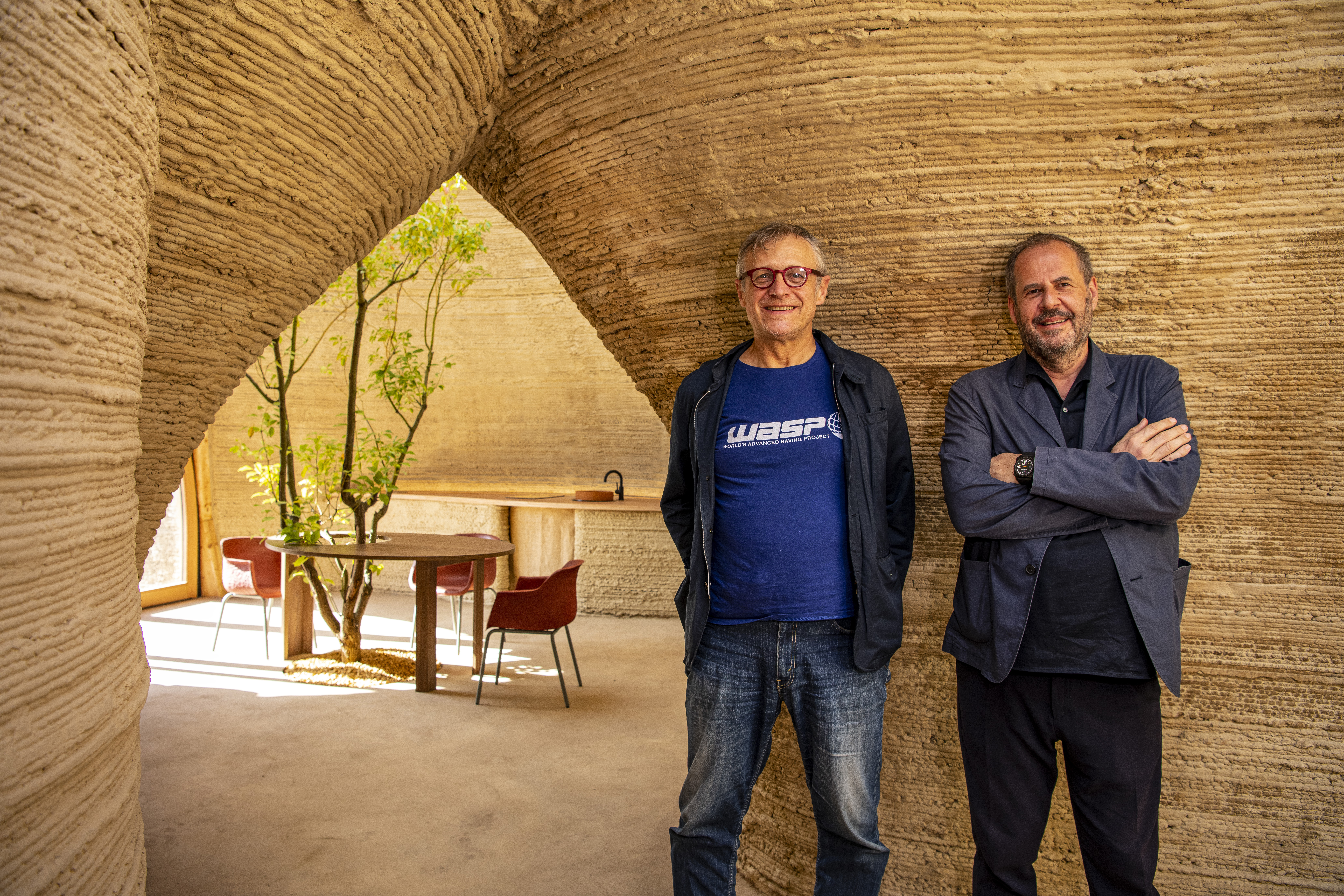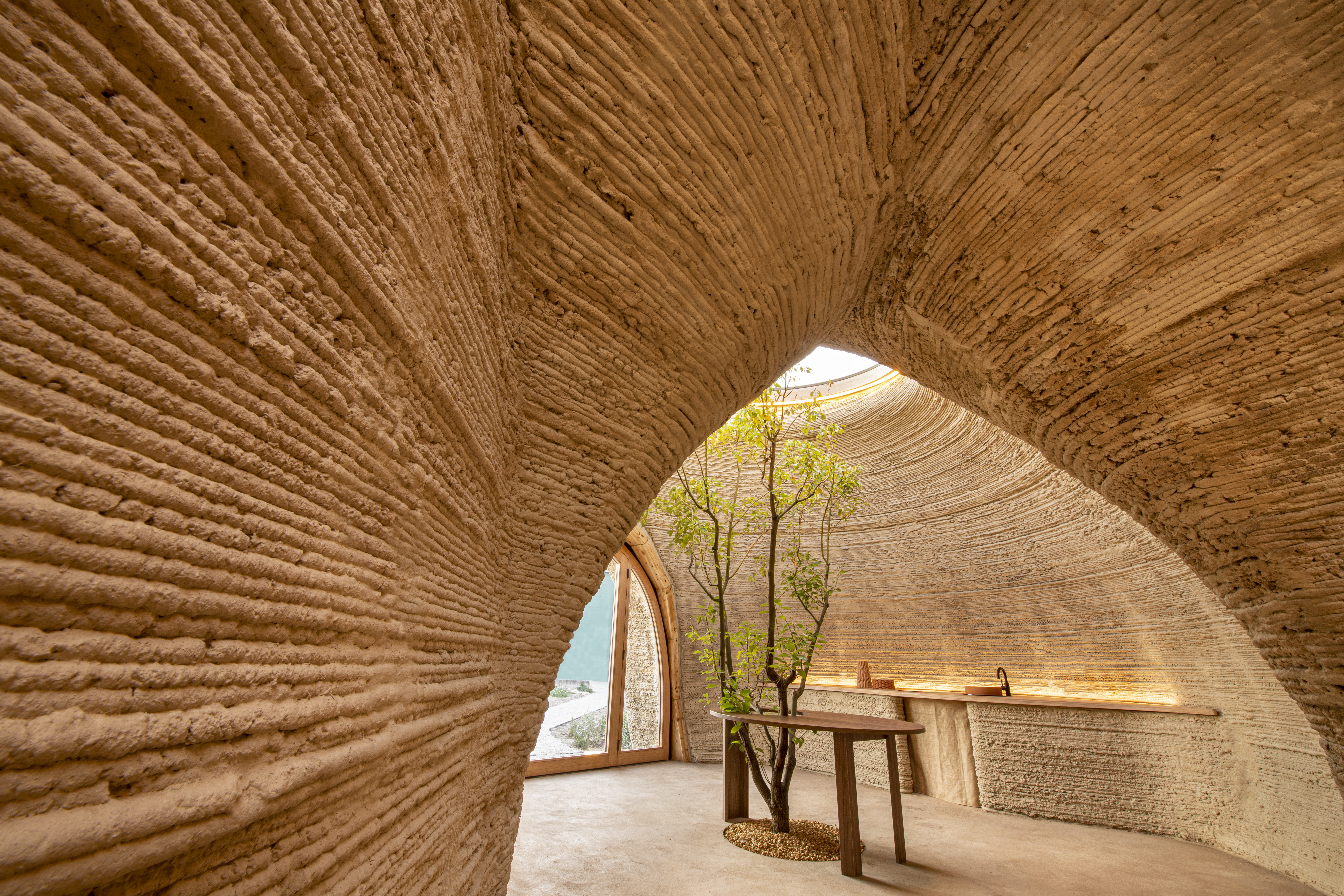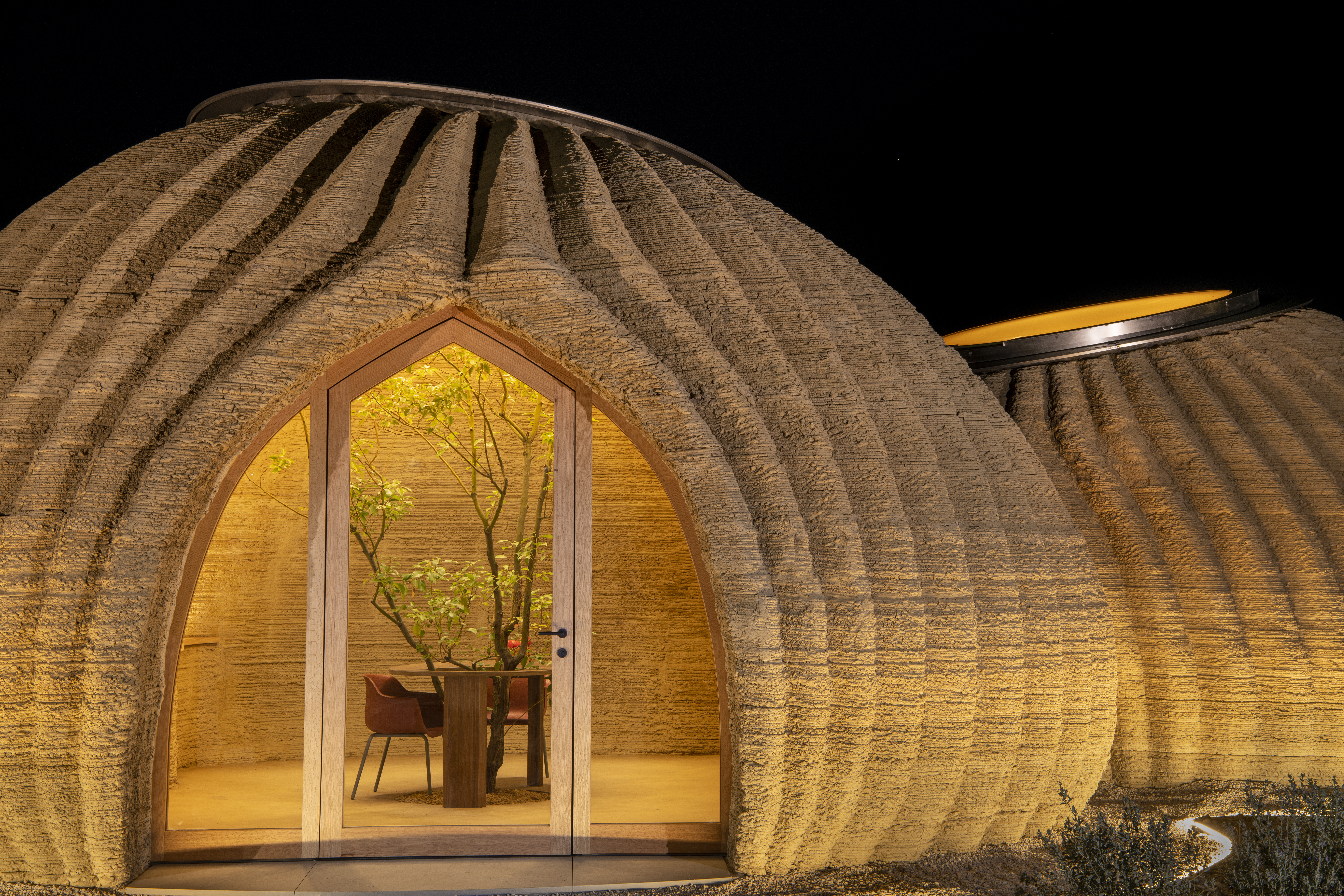Could 3D printed homes revolutionize urban planning? Probably not yet, but a pioneering Italian project is moving the needle forward when it comes to additively manufactured eco-habitats made of raw earth. The highly-publicized sustainable living project TECLA, designed by Mario Cucinella Architects (MCA) and engineered by WASP, is finally complete. Integrating sustainability, vernacular construction practices, bioclimatic principles, and on-site 3D construction, the collaborative plan resulted in an innovative, low carbon, circular housing model.
Completed in April 2021, the 3D structure occupies about 60 square meters, with a seating zone, kitchen, and night area. At first glance, it feels like stepping into a work of art, primarily due to the curvatures and minimalistic feel, utterly different to conventional housing structures or any of the century-old popular architectural home styles we have become accustomed to. Nevertheless, it is much more than that, the natural identity of the building feels much closer to Frank Lloyd Wright’s organic green designs, created by the American architect to flow and coexist with the natural life surrounding it.
Built in the Massa Lombarda region in northern Italy, the fully 3D printed TECLA model comprises two continuous structures that, through a sinuous and uninterrupted sine curve, culminate in two circular skylights that “convey the zenith light,” as stated by the company. From the geometry to the external ridges, its atypical shape has enabled the structural balance of the construction, both during the 3D printing phase of the envelope and once the covering was completed, giving life to an organic and visually coherent design.
Best of all, TECLA can be delivered after 200 hours of 3D printing (just over eight days), 7,000 machine g-codes, 350 twelve-mm layers, 150 km of extrusion, and 60 cubic meters of natural materials for an average consumption of less than six kW. The ambitious undertaking was possible using WASP’s specialized 3D construction cranes. The firm’s innovative 3D printing technology called Crane WASP is the company’s latest innovation in on-site 3D construction and the first in the world to be modular and multilevel.

The building process of TECLA using dual WASP Crane 3D printers for construction. Image courtesy of WASP/MCA.
Ideally designed to build construction works collaboratively, Crane WASP can use earth-based materials, concrete mortar, or geopolymers for construction. At a starting price of €132,000 ($160,000), the system is managed remotely via WiFi and weighs 150 kg. It reinterprets the classic building cranes from a digital manufacturing point of view and is composed of a central printer unit that can be assembled in different configurations depending on the printing area and the dimensions of the architectural structure. Once there is a single module, operators can expand it by adding traverses and printer arms, generating an infinite digital manufacturing system.
The model TECLA home used two synchronized printer arms simultaneously, thanks to software capable of optimizing movements, avoiding collisions, and ensuring streamlined operation. Each printer unit enveloped a printing area of 50 square meters, making it possible to build independent housing modules in just a few days. For the furnishings, the architects and designers chose to partly print them using local earth and integrate them into the raw-earth structure. These were also partly designed to be recycled or reused, reflecting the circular house model philosophy inherent throughout the entire project.
WASP, short for World’s Advanced Saving Project, is a 3D printing company founded by Massimo Moretti in 2012 and inspired by the Potter wasps, known for their distinguishable pot-shaped mud nests. Like the insects, WASP builds houses with natural materials and a cost tending to zero. For TECLA, that meant the innovative minds behind the project decided to make a structure that responds to the increasingly severe climate emergency, a growing need for sustainable homes, and an accentuated housing crisis worldwide.
For Moretti, TECLA shows that a beautiful, sustainable home can be built with a machine. While Mario Cucinella, Founder and Creative Director of Mario Cucinella Architects, highlighted that the culmination of their project is just the beginning of a new story. He emphasized that it would be truly extraordinary to shape the future by transforming an ancient material with novel technologies available today.

Massimo Moretti and Mario Cucinella at the TECLA 3D printed house in Italy. Image courtesy of WASP/MCA.
For this project, Mario Cucinella Architects not only explored housing solutions in formal aesthetic terms, but the team also studied the building’s shape in relation to the local climate and latitude. Additionally, the composition of the earth mixture responds to local climatic conditions. The filling of the envelope was parametrically optimized to balance thermal mass, insulation, and ventilation according to the climate needs.
Since it was introduced in 2018, Crane WASP has proven its technological capability to collaborate with architects worldwide for unique structural designs. The innovative platform is expected to print eco-districts on-site, with a low environmental impact. Expanding the uses for these revolutionary construction technologies could not only aid in reducing costs and intense labor requirements for building on Earth but they could potentially be used as humanity expands its frontier to outer space and demands additive technologies that can take moon or Martian regolith and turn it into sustainable housing units for space crew.
Subscribe to Our Email Newsletter
Stay up-to-date on all the latest news from the 3D printing industry and receive information and offers from third party vendors.
Print Services
Upload your 3D Models and get them printed quickly and efficiently.
You May Also Like
3D Printing News Briefs, June 28, 2025: Defense Accelerator, Surgical Models, & More
In this weekend’s 3D Printing News Briefs, 3YOURMIND was selected to join an EU Defense Accelerator, and PTC has announced model-based definition (MBD) capabilities within Onshape. Finally, a study out...
3D Printing News Briefs, June 7, 2025: Digital Inventory, Thermal Management Solutions, & More
In this weekend’s 3D Printing News Briefs, UK-based 3D printing bureau 3D People responds to global instability, and AEWIN chose Fabric8Labs’ technology for advanced thermal management solutions. We’ll end with...
Low-Cost Binocular Indirect Ophthalmoscope Made with CAD Software & Bambu Lab X1C
3D printing is increasingly used in the fabrication of diagnostic equipment, including ophthalmology, which is a medical specialty that deals with the diagnosis and treatment of eye conditions and diseases....
3D Printing News Briefs, May 17, 2025: Color-Changing Materials, Humanoid Robot, & More
We’re covering research innovations in today’s 3D Printing News Briefs! First, Penn Engineering developed 3D printed materials that change color under stress, and UC Berkeley researchers created an open source,...



































